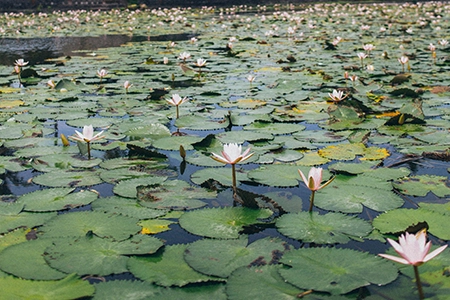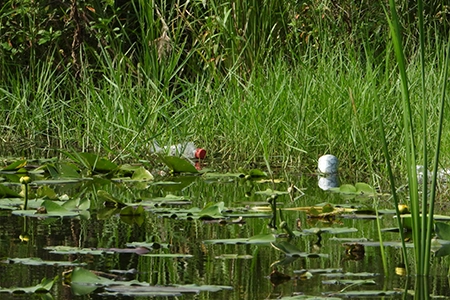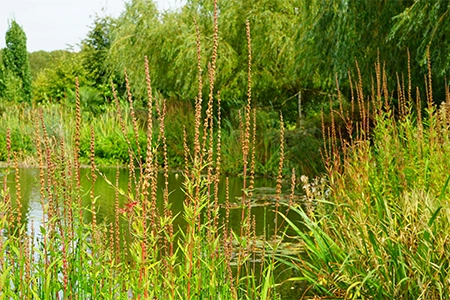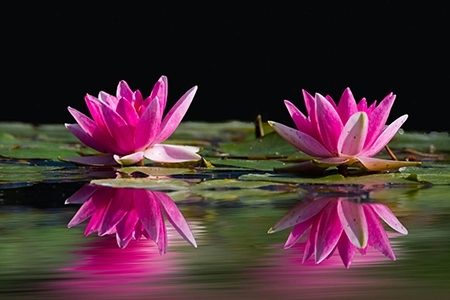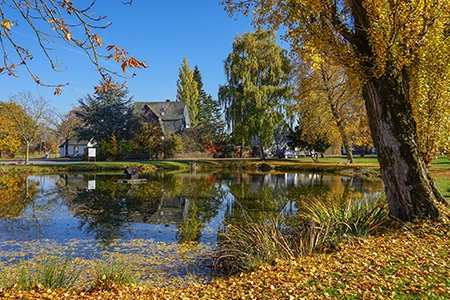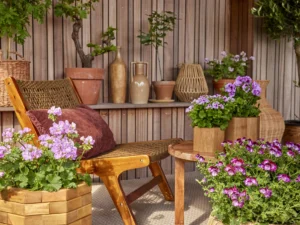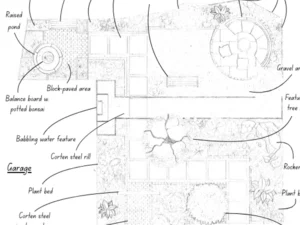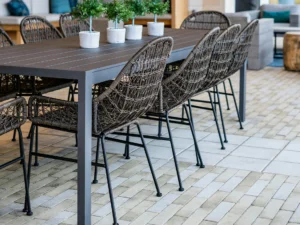Introduction
A pond is not just a decorative feature in your garden; it’s a thriving ecosystem that requires proper care and maintenance to stay healthy and vibrant. One crucial aspect of pond upkeep is ensuring adequate oxygen levels in the water, essential for the well-being of aquatic life and the overall clarity of the pond. In this article, we’ll explore the importance of choosing the best oxygenating pond plants and introduce you to some of the best options to revitalise your pond.
Having the Best Oxygenating Pond Plants is Essential
Oxygenating plants play a vital role in pond ecosystems by photosynthesising and releasing oxygen into the water. This oxygenation process is crucial for sustaining fish, frogs, and other aquatic organisms, ensuring they have enough oxygen to breathe and thrive. Additionally, oxygenating plants help to maintain water clarity by absorbing excess nutrients, preventing algae overgrowth, and reducing the risk of water stagnation.
Positioning the Best Oxygenating Pond Plants
When it comes to incorporating oxygenating plants into your pond, strategic placement is key to maximising their benefits and promoting a healthy aquatic environment. Different positions within the pond offer unique advantages, each playing a crucial role in maintaining water clarity, oxygen levels, and overall ecosystem balance. Here’s a closer look at the various positions for oxygenating plants and why they are imperative for a thriving pond ecosystem:
Submerged Best Oxygenating Pond Plants
Submerged oxygenating plants are typically placed at the bottom of the pond, where they root in the substrate and release oxygen directly into the water. These plants thrive in the deeper, cooler waters of the pond and play a vital role in oxygenation, nutrient absorption, and algae control. By photosynthesising underwater, submerged oxygenators help to oxygenate the water column, improving conditions for fish, invertebrates, and other aquatic organisms. Examples of submerged oxygenators include hornwort, waterweed, and anacharis.
Floating Best Oxygenating Pond Plants
Floating oxygenating plants are free-floating or anchored near the water’s surface, where they absorb nutrients and release oxygen into the air. These plants create shade and cover for fish and other aquatic life while helping to regulate water temperature and reduce algae growth. Floating oxygenators are particularly beneficial for small ponds and water gardens, where they provide natural filtration and improve water quality. Examples of floating best oxygenating pond plants include water lettuce, duckweed, and water hyacinth.
Emergent Oxygenators
Emergent oxygenating plants grow along the margins of the pond, with their roots submerged in water and their foliage extending above the surface. These plants provide vertical structure and habitat diversity, supporting a wide range of wildlife, including birds, amphibians, and insects. Emergent oxygenators also help to filter pollutants, stabilise shorelines, and reduce nutrient runoff into the pond. Examples of emergent oxygenators include dwarf water lily, parrot’s feather, and pickerelweed.
Marginal Oxygenators
Marginal oxygenating plants are positioned along the shallow edges of the pond, where they grow partially submerged or above the water’s surface. These plants help to oxygenate the water and stabilise the pond’s banks, preventing erosion and providing habitat for a variety of wildlife. Marginal oxygenators also enhance the aesthetic appeal of the pond, adding texture, colour, and visual interest to the shoreline. Examples of marginal oxygenators include snake’s head fritillary, water milfoil, and cyperus sedge.
The Best Oxygenating Pond Plants
Snake’s Head Fritillary
Snake’s Head Fritillary is a charming and unique addition to any pond. With its distinctive bell-shaped flowers in shades of purple and white, this spring-blooming plant adds beauty and interest to the pond’s edge while also oxygenating the water. Snake’s Head Fritillary prefers moist, well-drained soil and partial shade, making it an excellent choice for planting around the perimeter of the pond.
Anacharis
Anacharis, also known as Canadian waterweed, is another top contender for oxygenating ponds. This fast-growing plant boasts feathery, light-green foliage that oxygenates the water and helps to clarify it by absorbing excess nutrients. Anacharis is easy to care for and can be planted directly in the substrate or left to float freely in the water, making it a versatile and low-maintenance addition to any pond.
Waterweed
Similar to Anacharis, waterweed, or Elodea densa, is prized for its rapid growth and oxygenating capabilities. This submerged aquatic plant features slender, branching stems adorned with bright green foliage. Waterweed thrives in nutrient-rich water and can quickly fill empty spaces in the pond, outcompeting algae and improving water quality in the process. Regular pruning may be necessary to prevent overgrowth and maintain optimal oxygen levels.
Water Milfoil
Water milfoil is a genus of aquatic plants known for their delicate, fern-like leaves and oxygenating properties. These versatile plants come in various species, including Eurasian water milfoil (Myriophyllum spicatum) and common water milfoil (Myriophyllum aquaticum), each with its unique growth habits and preferences. Water milfoil forms dense, bushy foliage underwater, providing habitat and oxygenation for aquatic life while enhancing the aesthetic appeal of the pond. It should definitely be considered if you want the best oxygenating pond plants.
Parrot’s Feather
Parrot’s feather is a striking aquatic plant prized for its lush, feathery foliage and oxygenating capabilities. This versatile plant can be grown submerged or partially submerged in the water, making it an excellent choice for ponds of all sizes. Parrot’s feather adds texture and visual interest to the pond while oxygenating the water and improving overall water quality. However, it’s essential to monitor its growth carefully, as parrot’s feather can become invasive in certain environments.
Cyperus Sedge
Cyperus sedge, also known as umbrella palm or umbrella papyrus, is a unique addition to any pond landscape. With its tall, slender stems topped with umbrella-like clusters of leaves, cyperus sedge adds vertical interest and oxygenation to the pond. This water-loving plant thrives in wet, boggy conditions and can be grown along the water’s edge or in shallow areas of the pond. Cyperus sedge provides habitat for aquatic insects and small fish while also improving water quality through oxygenation and nutrient absorption.
Dwarf Water Lily
Dwarf water lilies are compact aquatic plants that pack a punch when it comes to oxygenation and aesthetic appeal. These miniature versions of their larger counterparts feature delicate, floating leaves and colourful blooms that add charm and elegance to the pond. Dwarf water lilies thrive in full sun to partial shade and can be planted directly on the substrate or grown in containers placed in the water. With their ability to oxygenate the water and provide shade for fish and other aquatic life, dwarf water lilies are a must-have for any pond enthusiast.
We Choose the Best Oxygenating Pond Plants
At NGS, we offer comprehensive assistance in selecting and incorporating the best oxygenating plants for your pond, ensuring optimal water quality and ecosystem health. With years of experience in landscaping and pond design, our professionals are well-versed in the characteristics and requirements of various oxygenating plants. We assess your pond’s size, depth, water quality, and surrounding environment to recommend the most suitable species, whether submerged, marginal, floating, or emergent, that thrive in your pond’s conditions and complement your aesthetic preferences.
We take a personalised approach to pond design, tailoring our recommendations to your unique landscape and vision. Whether you’re creating a naturalistic wildlife habitat, a formal water garden, or a contemporary aquatic feature, our team can help you incorporate oxygenating plants in a way that enhances the beauty and functionality of your pond.
From expert plant selection to professional installation services, including precise placement and establishment, NGS ensures every aspect of your pond’s oxygenators is meticulously handled and that you are supplied with the best oxygenating pond plants. Additionally, our ongoing maintenance and care services keep your aquatic ecosystem thriving, ensuring the health and vitality of your oxygenating plants year-round. With NGS as your partner, you can enjoy a vibrant and sustainable pond ecosystem that enhances the beauty and enjoyment of your outdoor space. To find out more about the services we offer get in touch via our Contact Us page!
Conclusion
In conclusion, oxygenating plants are essential for maintaining a healthy and vibrant pond ecosystem. By photosynthesising and releasing oxygen into the water, these plants support aquatic life and promote water clarity, ultimately enhancing the overall health and beauty of your pond. Strategic placement of the best oxygenating pond plants in different positions within the pond is crucial for maximising their benefits and creating a balanced aquatic environment.
With NGS’s expertise in pond design and landscaping, you can confidently choose and incorporate the best oxygenating plants for your pond. Our personalised approach ensures that every aspect of your pond’s oxygenators, from selection to installation and maintenance, is meticulously handled to ensure optimal water quality and ecosystem health. Partnering with NGS allows you to enjoy a vibrant and sustainable pond ecosystem that brings joy and beauty to your outdoor space for years to come.

